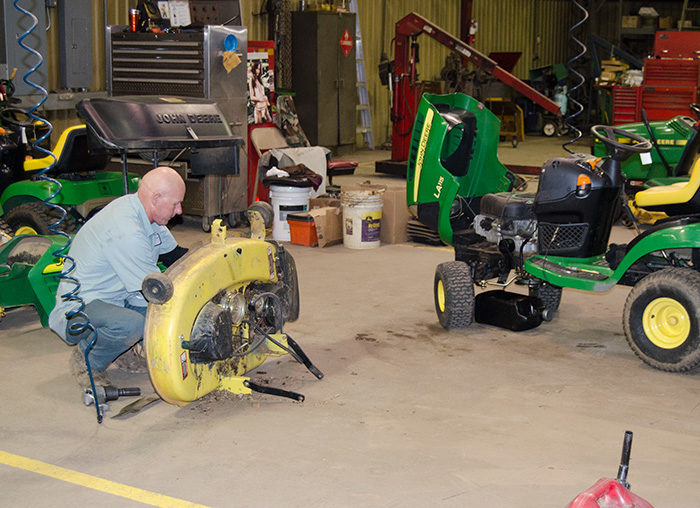Interested in printing this article out and sharing it with your staff? Click the button below for a printer-friendly version:
Printer-Friendly Version
Editor’s Note: You are currently reading Part 1 of “Maximizing Efficiency in Your Service Process.” In Part 2, Bob Clements discusses the final steps to perfecting your service process with an easy-to-follow system.
Every aspect of a dealership can be measured relative to time — it’s the one thing we all have in common. Every service department has the same amount of time available to them as do their competitors — how they use that time will determine their level of success and profitability. Each service department has a different number of people they employ and a different group of customers that come in but, for the most part, each employee in the department works about 8 hours each day. The difference between success and failure in a service department has to do with how the people in the department handle their time each day.
When I think of the importance of processes, I always look at how McDonald’s handles the complexity of their global business. Think about it for a moment: McDonald’s sells food, and their goal is to move as many people as possible in and out during their peak times using the fewest number of employees. However, they always work to make sure that each person that comes into the store or through the drive-thru has a positive experience with both the food they order and the McDonald’s employees they interact with.
If you think about how difficult it is to staff correctly and have the food prepared to meet the quality standards of over 30,000 locations around the world, it is amazing that they can do what they do. Because their processes are so refined, they can take someone like myself and, in a short period of time, put me in the right position that allows me to be successful and gives them the ability to achieve their goals — it’s all about their processes.
Create a High Performance Dealership with Bob Clements is a new series brought to you by Yanmar.
Yanmar — Don’t settle for less when you can have more. For example, Yanmar makes all its compact tractors’ major drivetrain components – the Yanmar engine, transmission, and axles — in-house. Because they’re made to work perfectly together, you and your customers get a hardworking machine with more usable horsepower, less power loss, and a smoother, more comfortable ride. Yanmar’s tractors are designed to work as hard as you do for a lifetime. Strengthen your dealership with Yanmar today: AgMarketing@yanmar.com or call 770-877-9894.
We can learn a lot from a company like McDonald’s if we understand that their business revolves around creating and refining what they do every day. What you do in your service department should be no different than what a McDonald’s manager does every day in their store.
Managing Time
I like to think of a service department like a pit stop in a NASCAR race. Think for a moment of how a pit stop works: First, the car doesn’t come into the pit until the pit crew is ready with everything they need to get the car in and out quickly. Time is of the essence in a race. If the cars on the track are averaging 160 mph and you lose just 1 second of time, you have lost 240 feet of the lead you had coming into the pit. In a race, just one second that you are not on the track can be the difference between winning or coming in 10 car lengths behind.
Pit crews are keenly aware of each tenth of a second they lose — that’s 24 feet and they now have moved from first to second. Because of the importance that time plays in the race, they are constantly working on better, more efficient ways to get their job done and get that car back out on the track. That’s where process comes into place. Everything they do has a process that they follow and constantly work to improve because they understand how time equals money in racing just as it does in your service department.
The goal in your service department is to document the processes you currently have and then work to improve those processes so you can get every second of billable time out of your shop. This will improve the profitability of the dealership and ultimately improve the satisfaction of your service customers.
One of the benefits for a service manager in improving the processes of the department is the sudden disappearance of chaos. Most of the shops that I am called in to work with look like a forest fire with a handful of “firefighters” running around trying to put out a hundred hot spots. The techs are constantly running to the manager looking for their next work order and then running outside to find the equipment, hoping that it’s somewhere close. The manager is scrambling to reach customers to get approvals or trying to find out information from the parts department on backorders. Everyone is busy, but the service department is losing money — all because the process is either broken or not in place.
Dealer Takeaways
-
Time is one thing all dealers have in common — every service department has the same amount of time available to them as do their competitors. Putting processes in place helps optimize that time and avoid lost time.
-
Think about service department repairs like pit stops in a NASCAR race and the service techs just like the pit crew. Time is of the essence on pit road and that's why the pit crew is constantly working on more efficient ways to get their job done.
-
The employees who have contact with customers should all be on the same page as far as the information they need to collect from pieces of equipment coming into the service department.
-
Also, be aware of the customer's experience — whether they are walking in your door or during a pickup with your driver.
Some of you may be saying right now, “You just don’t understand. My shop is different. My people are different and my area is different.” I’m telling you that it just doesn’t matter. My team and I have been consulting with service and parts departments for years and I have never found one yet that couldn’t be profitable if they followed the right processes.
As an owner or manager, you have to make the decision to put processes in place and then hold all of the people in the dealership accountable to follow them, regardless if they think it’s the right thing to do or not. As I tell the people in the shops I consult with, use my processes and work to improve them so they produce better and better results.
Getting Ready
As you build your service processes, think about the experience from the moment the customer is reached either at your dealership or during a pickup with your driver, all the way through to when the customer picks up their equipment or you deliver it back to them. Everything that happens between those two points needs to be a part of your process design.
You first need to consider how the work order is created and the information that must be included on it. If the equipment is picked up, you need to think about any information you will want the driver to gather during the process. If the customer is home during the pickup, the driver should ask the same questions to the customer as if the customer had walked up to your service counter.
At that point, the driver should also do the initial tagging, so when the equipment is delivered to the store everyone knows who it belongs to. If the driver notices a scratch or dent on the equipment, they should document it, take a photo and attach a note to the work order.
Once the work order is complete, then you need to document what happens next. In our process, a red piece of flagging tape is tied on the equipment along with a weather proof tag that has a number on it. Then the equipment is staged to an area by the service department so it can go through “triaging” that day or at least within 24 hours after the equipment has been at the store. The ribbons we use to mark equipment give you the ability to quickly identify the stage of the repair.
The red ribbon shows us that the equipment has been checked in and the work order is complete, but a technician has not done any type of evaluation of the equipment to see if there are issues outside of what the customer has stated. Your process should be designed to make sure that every piece of equipment that enters your dealership is evaluated within 24 hours. The goal is to treat the service department like a NASCAR pit stop so we can have the parts we need when the equipment enters the shop for the first time.
Once a qualified technician has evaluated the equipment, the red ribbon will be replaced with a blue ribbon.This shows that an initial evaluation has been completed and notes have been added explaining the issues, the parts that may be needed and the potential labor required.
At that point, the work order will be back in the hands of the service manager or the parts department, either to begin pulling parts or to build an estimate that will require customer approval. In either case, the shop is in a holding pattern.
The goal is to follow the process and let it take care of the flow and quality of work that takes place in your service department. Because this process continues over and over again, your techs are not waiting to find out what their next job is. When they come in each morning, the work is lined out and all the parts they need for each job are sitting on a shelf, right by their service area so when the equipment comes in, it is cleaned and ready to be repaired. They don’t lose any time because rarely are they ever away from their area and not turning wrenches.
Part 2: Final Steps in an Efficient Workflow
Create a High Performance Dealership with Bob Clements is a new series brought to you by Yanmar.
Yanmar — Don’t settle for less when you can have more. For example, Yanmar makes all its compact tractors’ major drivetrain components – the Yanmar engine, transmission, and axles — in-house. Because they’re made to work perfectly together, you and your customers get a hardworking machine with more usable horsepower, less power loss, and a smoother, more comfortable ride. Yanmar’s tractors are designed to work as hard as you do for a lifetime. Strengthen your dealership with Yanmar today: AgMarketing@yanmar.com or call 770-877-9894.







Post a comment
Report Abusive Comment